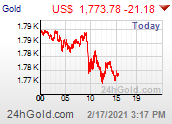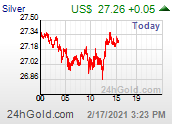
It's high time for a portfolio tracking update and more regular posting. The development of the blog and other services planned for the near future will evolve at a much faster rate going forward. Stay tuned. Catching up with some unfinished business, the official accounting entries of established positions appear below. All orders executed exactly as outlined in previous blog postings.
Gold positions have been a bit of a bummer, but overall portfolio performance kicked off a net gain of 5.66% between November 15th and December 14th. During the same period, the S&P 500 opened at 1,468.04 and closed last Friday at 1,467.95, for a rounding error loss of 0.09 points. Let's call it "unchanged" for the period. Market volatility has been absolutely wicked during this period, making the S&P's unchanged status for the period highly ironic.
All things considered, the model portfolio has turned in a satisfactory performance, with a strategic asset allocation creating a balance that has so far managed to weather overall market turmoil. Other than minor losses in China Life and Dianna Shipping, downside has been exclusively seen in precious metals focused positions.

Lesson From Livermore
The legendary speculator Jesse Livermore famously said, "Men who can both be right and sit tight are uncommon." Livermore understood his greatest profits came when he identified a trend and stuck to his convictions. Separating noise from a true change in a long-term trend is often more art than science. Indeed, sitting tight can be excruciatingly painful -- even downright lonely. No one ever said being a contrarian would be easy. But outsized profits are seldom had following the herd. The long-term bull market in gold and bear market in the US Dollar remain in place. Livermore might have "lightened-up" around the edges of trading positions, but we'd be so bold as to suggest he'd see this as but one more time where sitting tight is the most wise disposition.

Gold and Silver: Fundamentals Have Only Grown Stronger
Talk of Russian, Chinese, OPEC and other central bank diversification out of the US Dollar and into gold caught the market's imagination in 2005. Many will recall the famous Putin photo-op signaling the Russian central bank's reserves management shift. Don't believe the theater recently staged by Saudi Arabia for the benefit of providing political cover for the Gulf States. 2008 will see further movement among OPEC countries away from the dollar. The rise of titanic sovereign wealth funds will also serve to channel US dollars into real assets as China and other countries seek to diversify their foreign exchange holdings while securing strategic assets vital to their economic development. Above all else, bailing out the global financial system from the mortgage-backed asset credit crunch will prove to be a highly inflationary process.
In the short-term, we have seen the Canadian and UK central banks lower interest rates at a time when coordinated action to support the US Dollar is most helpful. Central banks have also acted in coordinated fashion to manage the rise of gold. The ECB dumped 42 tonnes of gold on to the market in November; all things considered, the fact that gold barely moved in the face of that onslaught just testifies to the power of the bull trend.
We've also seen the short-term impact of higher CPI and PPI inflation reports motivating currency traders to take the view that the US Fed will be less quick to cut rates going forward - a short-term positive arrow in the dollar bull's quiver. This is nothing but noise. The dollar may very well stage a short-term bounce that lasts for up to three months. That is what happened the last time dollar bearish sentiment became too excessive in the Dec. 2004 period. On balance, during 2008 the US Dollar will likely lose at least 15% vs. major trading currencies. Worse still, almost all major currencies will decline in value vis-a-vis gold as global central banks conduct a coordinated campaign to deal with the credit market crisis.
Anytime one can identify the causal factors behind the decline in a position or sector, it's possible to determine if "sitting tight" remains a fundamentally sound investment decision. At present, gold and silver shares are down for very specific reasons. November marked a near-term speculative peak that was capped by modest excessive bearishness in the dollar bear camp, but importantly, contrary to mainstream media representation we didn't see excessive bullish sentiment directly in gold nor silver.

KITCO.com web traffic statistics clearly demonstrate that the level of relative excitement among the general public investigating gold prices at the internet's leading precious metals quotation site prove in absolute quantitative terms that November's peak in the gold shares came at a time when far fewer investors were participating in the gold move. In fact, the last 18 months have marked a long and painful consolidation period, for the most part, where investors were punished by dreadful performance among "junior" gold and silver shares.
Tax loss selling is now upon us, adding insult to injury. Once again, the shares of "junior" companies are among those getting hit the hardest. This is to be expected given the poor level of investment sentiment throughout the sector and losses sustained in many of these shares earlier in the year. It's impossible to call the exact bottom, but within the next week or two, specific shares reverse and ultimately toss off gains of 30% on average for the entire sector over the coming three months - with many specific companies doubling or better.
We will be adding additional exposure to the junior gold and silver market sector in the days ahead. For now, we will establish an open order to buy an additional 2000 shares of Pediment Exploration at C$2.70. This order will be good until canceled. We will take no action on Carpathian Gold at this time. Tax loss selling in Carpathian has been particularly vicious, and investors are also apparently drawing unjust conclusions on the company's desire to add geographic diversification to it's project profile (e.g., concluding projects in Romania are in trouble when that is not the case).
# # # #
On November 23, 2007 the following positions were established:
- E-House (China) Holdings (EJ: NYSE): 100 shares were purchased on the open at $19.65
- San Gold Corp. (SGR.v: Venture Exchange, Canada): 3000 shares were purchased on the open at Canadian $1.30. The exchange rate opened that morning at 1.0145. Thus the position will be established with a US basis share price equivalent per share of US$1.319
- China Mobile (CHL: NYSE): 120 shares were purchased on the open at $84.07 per share
- China Life (LFC:NYSE): 120 shares were purchased on the open at $82.00
- National Oilwell Varco: (NOV: NYSE): 150 shares were purchased on the open at $65.67
- EnCana Corp. (ECA: NYSE): 100 shares were purchased on the open at $66.78
- ABB Ltd. (ABB: NYSE): 200 shares were purchased on the open at $27.06
- Diana Shipping (DSX: NYSE): 200 shares were purchased on the open at $31.50
- CF Industries Holdings (CF: NYSE): 100 shares were purchased on the open at $79.76
- Mosaic Co. (MOS: NYSE): 100 shares were purchased on the open at $60.84
- Potash Corp. (POT: NYSE): 50 shares were purchased on the open at $107.50
- Devon Energy Corp. (DVN: NYSE): 80 shares were purchased on the open at $85.95
Profile, Disclosure, Compliance and Disclaimer: Click Here


